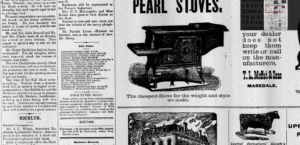I’ve got news for you, when we lose our community newspapers, it matters.
In mid-September, Metroland Media declared bankruptcy, stopping publication of 71 community newspapers, laying-off 605 people. Publications stopped their print editions across the province including Peterborough, Guelph, Bracebridge , Renfrew, Kemptville and more. The Perth Courier, also closed, printed its first edition in 1834.
This news broke my heart.
My writing career began in small town weekly newspapers in the late 1970’s. Even though I wandered away from that environment 40 years ago (!), I still think it is a great calling: to document the development of a community; to record our tragedies and triumphs; to shame and to exalt; to exclude and include; to cover up and reveal.
In the 1800’s, the community newspaper was one of the first signs of permanent settlement. Once the tavern, blacksmith, road and rail line, post office and dry goods stores were established, the newspaper was the next likely enterprise as European settlers moved across Ontario. I’ve read newspaper accounts of the first printing press arriving in a mid-Ontario town in 1878. Many people waited for the train to help with its relocation to the printer’s office. Within the week, they had printed their first edition.
Even villages, such as Highgate with a population of 500 people supported a weekly paper. The Highgate Monitor started its publication in 1895 but I am unsure when it ceased publication.
All this to say, that the weekly newspaper business has been evolving in this country for a couple of centuries.
Over those years, there have been countless disagreements about accuracy, political leanings, misleading articles and out-right shabby and irresponsible reporting but, in my mind, those are all out-weighed by the invaluable accounts saved for centuries of our communities’ histories. No, reportage is not perfect. More often than not, only a select group or point of view was promoted, but it does give us a snap shot of a period of time. Back then, it was common that a town could support two newspapers of different political persuasions printing their editions each week.
When I worked in the business, most newspapers were independent enterprises, but there was also a movement to consolidate and integrate, trying to maximize the advertising dollars by reducing editorial and printing expenses.
I’ve got news for you, at the time this appeared to be a brilliant business move and maybe it was, but it led to these mini-conglomerates being scooped up by even bigger media empires. And the farther the ownership moved from the community, so did the news.
Metroland’s closure announcement sited “changing preference of consumer and advertisers” blaming social media for taking advertising dollars and providing a platform for sharing information immediately.
How can a weekly newspaper compete with instant information and relatively cheap ad rates?
Become relevant to your community.
Each week, I receive a free circulation newspaper in our mailbox. It is owned, like many other local publications by a multi-media corporation. Often the front page picture is from a location many miles away, with almost no relevance to our community. There are columns by a well-known building contractor, horticulturalist, and financial advisor. None of them have a connection to our community. There is little coverage of council meetings, no features on local residents, no opinions on local concerns and no local photography features. In effect, no heart.
So, I think the big media companies missed the point of owning a community newspaper. Journalism needs to be interesting and thoughtful and about people who live in our community. Newspapers need to encourage discussion and evaluate local government decisions. Locally, newspapers need to record the events of our times. And yes, they need to be profitable.
(Full disclosure: I advertise my business every month on Facebook and Instagram and have stopped advertising in local weekly papers. The reason for this is that I can put my message in front of many people who are likely to be interested in my product. This has the effect of attracting people from Simcoe to Windsor to visit Palmyra. I also pay for only the people who ”click” on my ad. This usually costs me about $20 to fill an eight-person event. I don’t think an equivalent option at the same cost is available at the community newspaper level, but I am willing to listen if someone has an idea.)
I’ve got news for you, I think it is unlikely that multi-media empires can create a vital community newspaper. If we want this important institution to continue, it is time to act. I’d love to hear your ideas.

